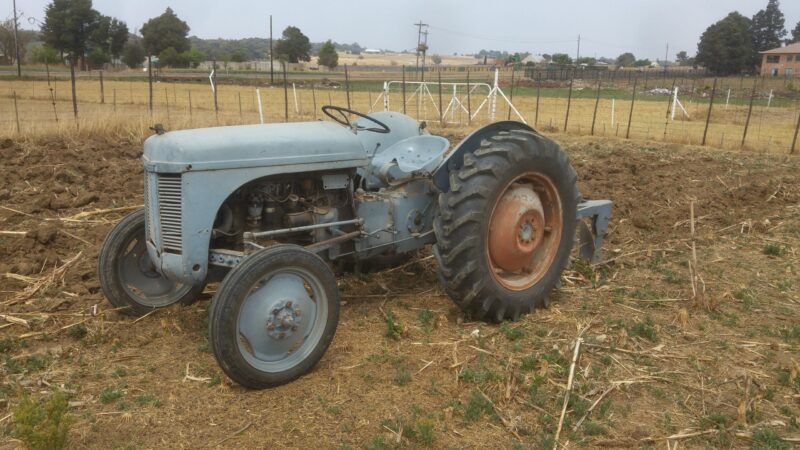Do you need a tractor on a smallholding? Or, perhaps put another way, can you justify the outlay on a tractor to work your land?
Think of it – a tractor, even a secondhand one and even a modestly sized one, will set you back tens of thousands of rands. Moreover, a tractor on its own is as useful as an empty swimming pool. You need an array of implements to hang off the back of your tractor to make it useful. And each of these, however small and old, will cost additional thousands of rands.
Mixed farm needs
If you run a “mixed” farm, with both pasture for grazing animals and planted crops you will need implements for grass cutting and raking, and possibly baling, as well as ground-engaging implements for working the soil. And you will need a trailer (perhaps the most useful implement of all).
With the wide array of implements available, there’s one to help you with every and any agricultural task, from spreading fertilizer and seed, to spraying crops and trees, to mixing concrete, or to mixing feed – apart from the more obvious ploughs, tillers, cutters etc.
And, apart from the initial outlay on the machinery there are inevitable maintenance and running cost.
Spares and components
Filters, wear parts, hoses and drive belts will need replacing. Tyres need inflating (so you will need an air pump of some sort). Tyres also perish, even if they don’t wear down, and need periodic replacing. Batteries don’t last forever and likewise need replacing. And then there is fuel, oils (hydraulic and engine) and grease for all those grease points on both the tractor and the implements.
Next, how good a mechanic are you? There will be times when your tractor refuses to start, or smokes, or leaks oil or water.
Are you comfortable spending time troubleshooting, sourcing spares and tinkering.
Likewise, it is quite likely that you will break something on the tractor or an implement. How good is your metalworking knowledge, such as welding?
Workshop costs
For if, for any such tasks, you have to send these or a workshop, extra expense will be incurred.
Then, all of this needs to be kept securely when not in use. While simple implements can be stored in a yard uncovered, the tractor itself, and more intricate implements such as shredders, balers etc, will benefit from undercover storage. Which means building an “afdak” at the very least.
Little use on a plot
Finally, how often, and for how long, will all of this equipment be used on a smallholding?
Depending on the task and the size of your land a mixed use smallholding will probably see a tractor in action for no more than seven to ten days total use in a year. A day or two for ground preparation for crop planting, another day or two for haycutting, raking and baling (assuming you use a tractor-driven baler), a day or two a couple of times a season for orchard or crop spraying (assuming you have a commercially-sized orchard otherwise this can be done by hand). And a day for ploughing and raking firebreaks.
In addition, if you have stables there might be a bit of moving feed, bedding and manure about, and if you are in the process of building something, a few days of concrete mixing, moving building material and the like. And if you are lucky enough to fell your own trees you might use the tractor and a chipper to grind up scrub for wood chips as mulch.
Weekend farmer
If you have a 9-5 job off the property these tasks will be accomplished, depending on the season, over weekends.
And there are options that don’t require a tractor for most of these tasks.
If you keep livestock you will probably suffer the smallholder malaise of overgrazing your pastures. Horses are the worst culprits in this regard (Springbok golfer and racehorse breeder Gary Player once said his father’s advice, when he started breeding, was “never keep an animal that east while you sleep!”).
Overgrazed land, even lightly grazed land, won’t need cutting, and certainly won’t result in needing raking, baling etc. So, scrap the slasher, rake and baler.
No till planting
Conservation agriculture techniques now favour no-till planting for a number of reasons, not least of which are preservation of the humus, earthworms and micro-organisms in the soil, as well as moisture retention. So, scrap the plough, rotavator, ridger, harrow etc.
Fruit orchards can be sprayed by backpack sprayer, either hand-operated or motorised. And often this task is better accomplished manually because the operator can direct the mist or spray more accurately at the branches than can be achieved by a tractor drawn sprayer.
For the other tasks, such as concrete mixing, chipping etc, electrically-driven or petrol (or diesel) powered alternatives exist to assist you.
Firebreaks
or one’s annual firebreak preparation task there is the alternative of burning rather than ploughing breaks. Or, for this, and for any other task, there is the option of calling in a contractor for a morning or a day as needed to do the task for you.
So you’re left with a trailer for carting bedding, manure and feed. Which can be drawn by a ride-on mower (not for nothing often called a lawn tractor) or a small bakkie, which can be used for other daily tasks as well.
Lifestyle choice
But, for many smallholders, “playing farmer” is a lifestyle choice. For such people, to spend a few weekends a year astride a tractor, enjoying the fresh air and sunshine as one accomplishes whatever task one is tackling, is as much about personal enjoyment and relaxation as it is about being agricultural.
Main image: Ferguson Vaaljapie working a smallholder’s field with a plough. SA Smallholder image.

